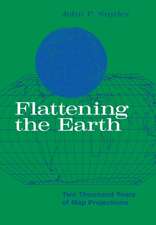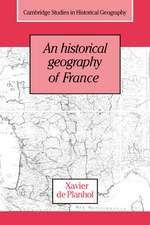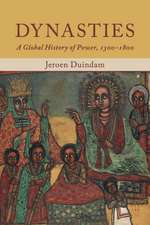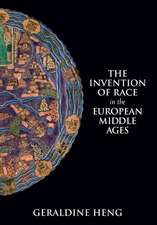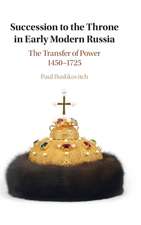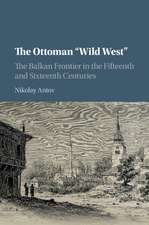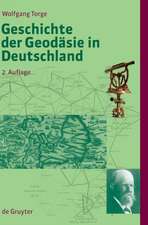Cartographic Humanism: The Making of Early Modern Europe
Autor Katharina N. Piechockien Limba Engleză Paperback – 13 sep 2021
Piechocki calls for an examination of the idea of Europe as a geographical concept, tracing its development in the 15th and 16th centuries.
What is “Europe,” and when did it come to be? In the Renaissance, the term “Europe” circulated widely. But as Katharina N. Piechocki argues in this compelling book, the continent itself was only in the making in the fifteenth and sixteenth centuries.
Cartographic Humanism sheds new light on how humanists negotiated and defined Europe’s boundaries at a momentous shift in the continent’s formation: when a new imagining of Europe was driven by the rise of cartography. As Piechocki shows, this tool of geography, philosophy, and philology was used not only to represent but, more importantly, also to shape and promote an image of Europe quite unparalleled in previous centuries. Engaging with poets, historians, and mapmakers, Piechocki resists an easy categorization of the continent, scrutinizing Europe as an unexamined category that demands a much more careful and nuanced investigation than scholars of early modernity have hitherto undertaken. Unprecedented in its geographic scope, Cartographic Humanism is the first book to chart new itineraries across Europe as it brings France, Germany, Italy, Poland, and Portugal into a lively, interdisciplinary dialogue.
What is “Europe,” and when did it come to be? In the Renaissance, the term “Europe” circulated widely. But as Katharina N. Piechocki argues in this compelling book, the continent itself was only in the making in the fifteenth and sixteenth centuries.
Cartographic Humanism sheds new light on how humanists negotiated and defined Europe’s boundaries at a momentous shift in the continent’s formation: when a new imagining of Europe was driven by the rise of cartography. As Piechocki shows, this tool of geography, philosophy, and philology was used not only to represent but, more importantly, also to shape and promote an image of Europe quite unparalleled in previous centuries. Engaging with poets, historians, and mapmakers, Piechocki resists an easy categorization of the continent, scrutinizing Europe as an unexamined category that demands a much more careful and nuanced investigation than scholars of early modernity have hitherto undertaken. Unprecedented in its geographic scope, Cartographic Humanism is the first book to chart new itineraries across Europe as it brings France, Germany, Italy, Poland, and Portugal into a lively, interdisciplinary dialogue.
Preț: 238.12 lei
Nou
Puncte Express: 357
Preț estimativ în valută:
45.58€ • 49.53$ • 38.31£
45.58€ • 49.53$ • 38.31£
Carte disponibilă
Livrare economică 31 martie-14 aprilie
Livrare express 14-20 martie pentru 26.37 lei
Preluare comenzi: 021 569.72.76
Specificații
ISBN-13: 9780226816814
ISBN-10: 0226816818
Pagini: 304
Ilustrații: 23 halftones
Dimensiuni: 152 x 229 x 22 mm
Greutate: 0.43 kg
Ediția:First Edition
Editura: University of Chicago Press
Colecția University of Chicago Press
ISBN-10: 0226816818
Pagini: 304
Ilustrații: 23 halftones
Dimensiuni: 152 x 229 x 22 mm
Greutate: 0.43 kg
Ediția:First Edition
Editura: University of Chicago Press
Colecția University of Chicago Press
Notă biografică
Katharina N. Piechocki is associate professor of comparative literature at Harvard University.
Cuprins
List of Figures
A Note on Translations
A Note on Translations
Introduction
1. Gridding Europe’s Navel: Conrad Celtis’s Quatuor Libri Amorum secundum Quatuor Latera Germanie (1502)
2. A Border Studies Manifesto: Maciej Miechowita’s Tractatus de Duabus Sarmatiis (1517)
3. The Alpha and the Alif: Continental Ambivalence in Geoffroy Tory’s Champ fleury (1529)
4. Syphilitic Borders and Continents in Flux: Girolamo Fracastoro’s Syphilis sive Morbus Gallicus (1530)
5. Cartographic Curses: Europe and the Ptolemaic Poetics of Os Lusíadas (1572)
Conclusion
Acknowledgments
Notes
Index
Notes
Index
Recenzii
"Piechocki is conceptually rigorous, she reads many languages and her research is impeccable. She is a careful critic but also a deeply imaginative historian. This is a contribution to the 'darker side' of cartography and the Renaissance, emphasizing the relationship between writing and scholarship and the exercise of power and exploitation, but its analysis never departs from the measured and reflective."
"This is an ambitious book which convincingly achieves its goals. It makes great claims for Humanism, the Renaissance and especially for cartography in establishing a new idea of Europe, and presents detailed evidence for those claims in closely argued and highly detailed case studies."
"[A] timely book...well worth a read."
“Through a close reading of literary texts, Cartographic Humanism traces a shift in understanding of the shapes, meanings, relationships, and constituent parts of the globe. Piechocki’s linguistic range is astounding, and her fluid translations convey the poetry of the original passages. She has assembled a rich array of texts and images, and the imaginative ways in which she reads them add up to something new and compelling. She draws out their cartographic ideas and makes a convincing case for their centrality in defining both Europe and its swaggering presence across the globe. Her readings are fresh and energetic. The book will be a major contribution to literary and cultural studies and their intersection with the history of cartography.”
"Katharina Piechocki’s Cartographic Humanism is an indispensable book for scholars in many disciplines who think or write about cartography, Europeanness, or [the] Renaissance."
"Cartographic Humanism is the wonderful achievement of a major critic, scholar, literary historian and multicultural thinker. With wide-ranging scholarship, philological acuteness, sensitivity to textual and poetic nuance, and enviable linguistic ease in Latin, German, Polish, French, Italian, Spanish, English and Portuguese, Katharina Piechocki offers a new understanding of the sixteenth-century cartographic invention of Europe from a pot-pourri of real and imagined borderlands. In taut analyses of writers little studied outside specialist contexts or well-known but not as mappers of a new Europe—Conrad Celtis, Maciej Miechowita, Geoffroy Tory, Girolamo Fracastoro and Luís Vaz de Camões—Piechocki tracks a cartopoietic story that 'starts' with efforts to delimit central (Germanic), eastern (Polish or 'Sarmatic') and a core (French) 'Europe' from and against indeterminate or non-existent Asian, Mediterranean and African borders, passes through attempts to establish this 'place' against an also indeterminate other—'America' or 'not-Europe,' all intimately bound, in Fracastoro, to disease and/or its cure and to the fictive imagination, and 'ends' with Camões’ nomad poetic imposition of a colonizing Mediterranean map on an age-old Indian Ocean one, a European cartography on and of the world. In the effervescent Renaissance scholarship of history as cartography Piechocki’s is a splendidly compelling new voice, one, too, that lets us see hitherto silent or 'peripheral' actors as key to modern Europe’s invention."
"Cartographic Humanism is a tour de force. Impeccably researched and beautifully written, this major intervention into the histories of cartography and literature asks what we mean when we say ‘Europe.’ Piechocki addresses this question—so urgent today—by exploring how early modern poets and mapmakers imagined interstitial geographies and, thus, Europe’s ever-changing borders and contact zones. Drawing from a rich multilingual archive of humanists from Germany, Poland, France, Italy, and Portugal, Cartographic Humanism shows that Europe is not a monolith and never was. A must-read not only for scholars of early modernity, but for anyone who has ever said the word ‘Europe.’”
“Cartographic Humanism is a deeply ambitious, exhaustively researched, and carefully argued book that covers a number of literary and historical issues in Renaissance European culture. Piechocki successfully brings together the unwieldy materials of language, local identification, a multidisciplinary approach, and temporal breadth, providing valuable insight into Latin humanist texts that undergird more familiar vernacular cartographic texts.”
"Katharina N. Piechocki’s elegant and incisive new work on how an assemblage of sixteenth-century humanists took the classical designation of 'Europa' and transformed it from a loosely defined appendage to Asia’s landmass into a more sharply delineated territory with political and metaphysical overtones."
"How did Europe emerge through pictorial maps, and what did early Renaissance maps and cartopoetics have to do with that emergence? Cartographic Humanism is an intertextual study of the history of cartography that looks at transnational spaces of fantasy and exploration, knowledge and emotion, and symbolic places and claimed discovery. . . .In this effervescent book of literary criticism and the map, there is much creative ground to be gained."
"Piechocki's study is a complex contribution to the study of the understanding of Europe in the Renaissance... Although this is never explicitly mentioned by the author herself, this book can also be understood as a serious examination of the reception of Ptolemaic geography in the 15th and 16th centuries... Piechocki's impressive contribution remeasures the broad field of early modern European research."



